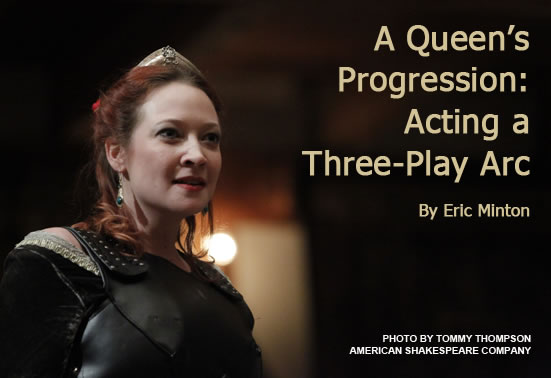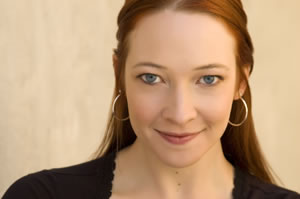
The list of Shakespeare’s iconic female characters is long. Certainly, most people would include Lady Macbeth, Cleopatra, Beatrice, Viola, and Rosalind; perhaps Desdemona, Hermione, Juliet, Titania, and the shrewish Kate, too. These are the parts actresses clamor to play at least once in their careers.
Sarah Fallon believes another part should be on that list, the antecedent to all of those other Shakespearean women: Margaret of Anjou, who first appears in Henry VI, Part 1, and becomes queen and such a force in Parts 2 and 3 that Shakespeare inserted her, unhistorically, into Richard III. Fallon played Margaret in the Henry plays over three seasons for the American Shakespeare Center at the Blackfriars Theatre in Staunton, Va., and in method and manner she played the part as perhaps no woman has done before (as a boy has, yes; as a woman, probably not).
“There’s not anybody who gets the scope Shakespeare’s given Margaret,” Fallon said. This from an actress who has played Rosalind, Titania, Beatrice twice and Kate three times, as well as a few other strong Shakespearean women, such as Regan in King Lear, Isabella in Measure for Measure, and Tamora in Titus Andronicus. “And it’s funny to me, too, because I feel like she’s often overlooked. I think that even if you talk to Shakespearean actresses, and ask them what roles do you want to play and what roles do you admire, Margaret very rarely comes up. It’s probably because these plays are done so infrequently, and because people hear a history title and they go ‘ewwww! that’s got to be really boring.’ But these Henry VI plays are anything but boring, and they have this great female role in it.”
Most audiences have only seen Margaret in Richard III (when directors don’t cut her out of the play altogether) and, based on those encounters, would tend to see her as some crazy lady with a grudge. This reputation Fallon considers totally unfair. “I believe that [the Henry VI plays] should be standard reading, or viewing if at all possible, for anyone who goes to see Richard III, especially from Margaret’s perspective, to get a sense of what many of these characters have already been through—and that's a hell of a lot,” she said. “Margaret is not just some crazed bitch walking around court cursing people—she has a lot of reasons why she is the way that she is.” Indeed, only one character introduced in Henry VI, Part 1, is still alive at the end of Richard III: Margaret. “Shakespeare probably found her extremely interesting, and it’s way more interesting to have Margaret alive than dead,” Fallon said.
The few times the Henry VI plays are produced, companies often conflate the three plays into two parts (and sometimes add Richard into a three-play set) or stage all three in repertoire for one season. ASC offered up the Henry trilogy one part at a time one season after another, from 2009 to 2011, with Richard III on the 2012 schedule. Thus, Fallon, in a sense, grew up with the part. Though she first met Margaret in a production of Richard III, in which the actress played Elizabeth, Fallon had never read or seen theHenry VI plays before playing Margaret in Part 1. At the time, she couldn’t reconcile the romantic young duke’s daughter with the “crazed bitch” of the fourth play, and the only thing she knew of Margaret’s subsequent behavior in the rest of the trilogy was that she, as queen, would be cuddling the severed head of her illicit lover in full view of the king and his lords. A year later, a year older, Fallon played Margaret as the scourge of England in Part 2, relishing the head scene most of all. “It didn’t take much to get where I needed to go,” she said. “It was a woman who had lost her love walking on stage with his head.” Another year of the actress’s life would pass before she re-emerged on the Blackfriars stage as the she-wolf with a tiger’s heart in Part 3. She’s now totally reconciled to being a crazed bitch next year as she's been tapped to play the queen again in Richard III.
For professional reasons and historical purposes, Fallon did not read ahead to Parts 2and 3 for her role in Part 1. ASC performs in the world’s only replica of the Blackfriars, the indoor theater used by Shakespeare’s company, with the same staging conditions The King’s Men would have known: namely, universal lighting, no electronic effects, and an audience all around, including on the stage (the “gallants' stools”) and in the gallery above. ASC also uses the tradition of cross-gender casting, but with 21st century equal opportunity. Thus, King Henry was played by actresses, Alyssa Wilmoth in Part 1and Denice Burbach in Part 2, before an actor took on the role in Part 3, Gregory Jon Phelps, who had played Suffolk in the first two parts. Miriam Donald played the part of her son, Prince Edward, “Ned,” in Part 3. The actors also perform music—usually pop rock and country songs echoing the play’s themes—before the play and during the intervals.
Furthermore, the Henry VI series was produced as part of ASC’s annual Actors’ Renaissance Season (which the actors call “The Ren Season” for short) in which the company replicates the production principles of Shakespeare’s time. Each of the 13 actors receives only his or her parts (many double and triple roles in a single play, such as Chris Johnston playing Clifford, King Lewis of France, and Hastings inPart 3) plus cue lines. They must memorize their lines, come up with their own costumes and props (including the above-mentioned head of Margaret’s lover), and, with no director, work out all the scenes, including blocking, in a rehearsal time totaling about 50 hours per play. All of this happens in a repertoire of five plays being staged in like manner, including three by Shakespeare contemporaries, a couple of those often making their North American debuts. A prompter is on hand for any actor who forgets a line and calls “prithee”; it happens, at most, once or twice per play, but resulted in a genuinely sweet moment in Henry VI, Part 1, when Phelps as Suffolk lost his place in the meeting scene with Margaret: “Prithee!” he called. “She’s beautiful,” the prompter intoned. “She is beautiful!” Suffolk cooed as if confirming the prompter’s opinion.
In the Blackfriars environment and the Ren Season conditions, Fallon took on the job of playing Margaret over three successive years in much the same way the very first Margaret himself would have. “I like the fact that I’m not looking so ahead, where I’m going, ‘Well, now I’ve got to set myself up for this’ and I’m just playing what’s there,” she said. “I’m trying to play what’s there in the story and what Shakespeare’s given me and where she is.”
It may be the best way to totally appreciate this character of Shakespeare’s, then a novice playwright, as it comes to life on a bare stage with other players birthing their own characters and no midwife director imposing extra-contextual interpretations and inventions. What we see with this purest of Margarets is a part that not only paved the way for all of Shakespeare’s iconic females to follow, but a character so popular in 1592—the first reference to Shakespeare as a playwright in London quotes one of Margaret’s lines—that the playwright found a way to bring her back for Richard III (making Margaret a forerunner of Indiana Jones and Jack Sparrow, too; even Falstaff didn’t make it to a fourth play, as Shakespeare promised he would). “You get to go through so much playing this woman, especially if you get to play her—if you are lucky enough to play her—in all three parts; and separate productions of all three parts,” Fallon said.
A native of Texas, Fallon earned her bachelor’s of arts in theatre at Trinity University in San Antonio, Texas, and a master’s of fine arts in acting at the University of Delaware. She worked four seasons at the Colorado Shakespeare Festival (2001–2003 and 2007) and has been with ASC off-and-on since 2004, playing 52 roles in 39 productions.
On a rare moment of relaxation for Fallon—the fifth and final play of the Actors’ Renaissance Season’s repertoire, when Thomas Middleton’sA Trick to Catch the Old Ones had just opened four days before—my wife, Sarah, and I sat down with the actress March 29, 2011, over wine in the lounge of the Stonewall Jackson Hotel in Staunton, Va., and afterward dinner at the Mill Street Grill to talk about Shakespeare’s great Queen Margaret.

No comments:
Post a Comment